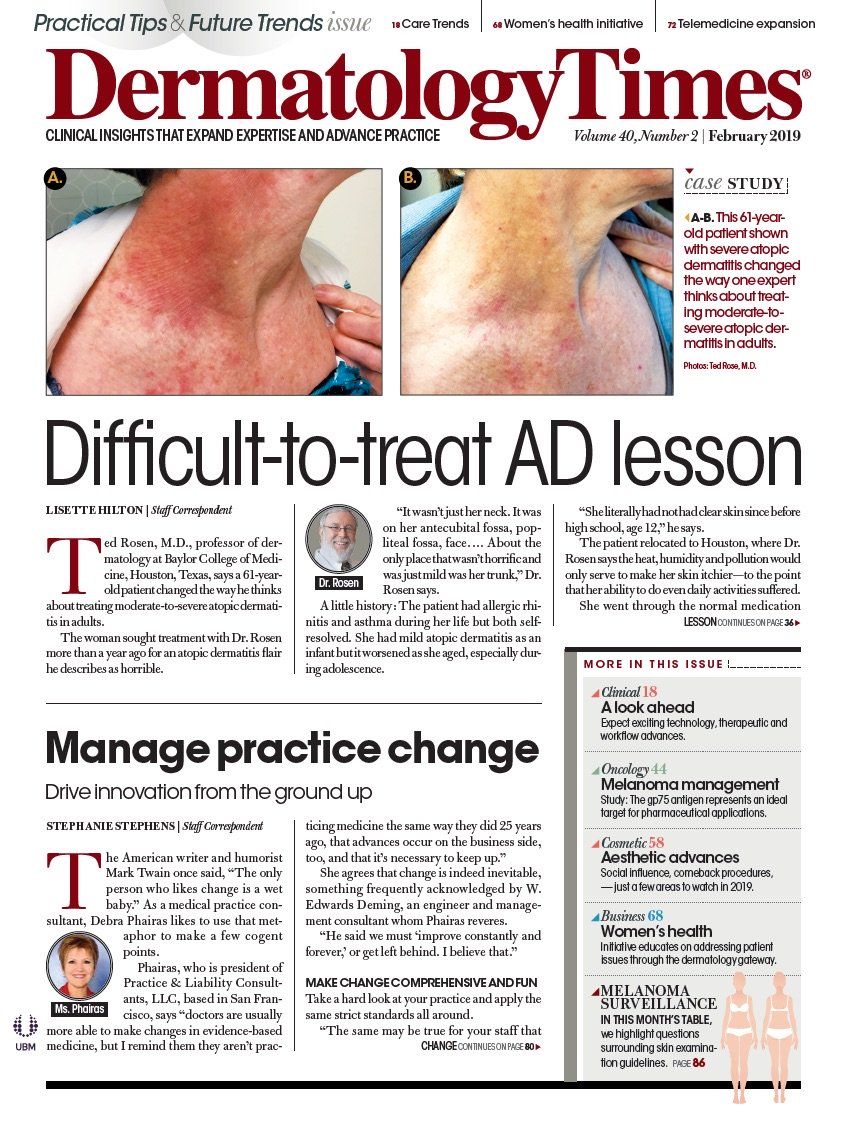- Case-Based Roundtable
- General Dermatology
- Eczema
- Chronic Hand Eczema
- Alopecia
- Aesthetics
- Vitiligo
- COVID-19
- Actinic Keratosis
- Precision Medicine and Biologics
- Rare Disease
- Wound Care
- Rosacea
- Psoriasis
- Psoriatic Arthritis
- Atopic Dermatitis
- Melasma
- NP and PA
- Skin Cancer
- Hidradenitis Suppurativa
- Drug Watch
- Pigmentary Disorders
- Acne
- Pediatric Dermatology
- Practice Management
- Prurigo Nodularis
- Buy-and-Bill
Publication
Article
Dermatology Times
Two big trends in cosmeceuticals for 2019
Author(s):
Organic and microbiome friendly cosmeceuticals are two big trends to watch out for in 2019, according to this physician.
“You’re going to see a lot of cosmetic products and cosmeceuticals stating that they’re microbiome friendly. That’s an interesting twist because no one was ever previously concerned about preserving the bacteria on the skin’s surface,” says Dr. Draelos. (paulyann - stock.adobe.com)

Dr. Draelos is a consulting professor of dermatology,Duke University School of Medicine, Durham, N.C.

Trending in cosmeceuticals for 2019: products that are organic and microbiome friendly, according to dermatologist Zoe Diana Draelos, M.D., who practices in High Point, N.C., and founded Dermatology Consulting Services, a company that works with cosmeceutical firms to develop formulations and conduct product testing.
ORGANIC, PLEASE
Consumers want more than organic food; they want organic skincare, including “natural” ingredients that are sustainable and plant-based, as well as products free of petroleum distillates, including petroleum jelly and mineral oil, according to Dr. Draelos.
Next to product claims, such as hypoallergenic, noncomedogenic and non-acnegenic, companies are adding organic, natural and sustainable, she says. But the reality is that claiming a product is natural could mean it contains anything found on the earth. Many consumers’ expectation is that natural ingredients are plant-derived, according to Dr. Draelos.
“‘Bad’ ingredients are silicone, because while it comes from sand it’s not naturally available and has to be made, and petroleum distillates, because crude oil comes from the ground but has to be distilled in order to get the various fragments,” Dr. Draelos says.
“People are eliminating these supposed bad ingredients and trying to find similar plant-based substances.”
FOCUSING ON THE MICROBIOME
The trend in 2019 is to develop skincare products that don’t damage the microbiome, according to Dr. Draelos.
“You’re going to see a lot of cosmetic products and cosmeceuticals stating that they’re microbiome friendly. That’s an interesting twist because no one was ever previously concerned about preserving the bacteria on the skin’s surface,” she says.
The concept is to choose a preservative that would be in a concentration low enough to kill bacteria without theoretically affecting the
microbiome. Manufacturers also are looking at ways of enhancing and normalizing the microbiome, while pushing out disease-causing organisms.
“For example in acne, there are many different strains of Propionibacterium acne. Some are more pathogenic; some are less pathogenic. But the idea would be to put a product on your face that would allow bacteria, such as lactobacillus, to populate the face, crowding out the Propionibacterium acne thus allowing acne to get better,” she says.
The two diseases that are most interesting in this space are atopic dermatitis, because the aim is to push out Staphylococcus aureus, and acne, where the products would try to push out pathogenic strains of Propionibacterium acne.
“It would be like putting a yogurt type solution on your face to try and repopulate your face or your body (in the case of atopic dermatitis) with nonpathogenic bacteria--getting rid of the pathogenic bacteria not by destroying them, like you would with an antibiotic, but by crowding them out because every bacterium has to have a piece of skin to live on,” Dr. Draelos says.
“The idea is to colonize your skin with non-disease-causing organisms and to crowd out the bacteria that cause disease--basically starve them out, because there’s no real estate on the skin’s surface on which they can grow.”






